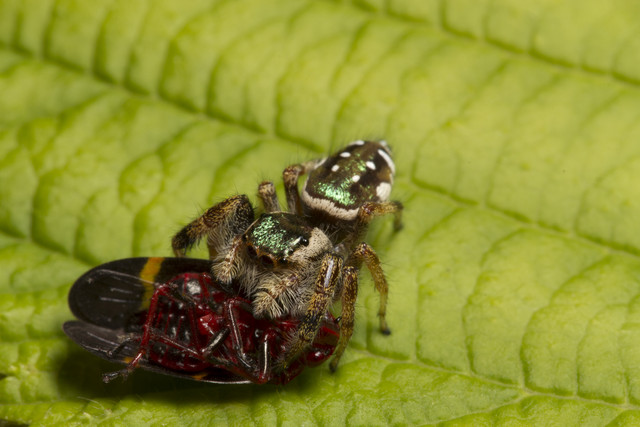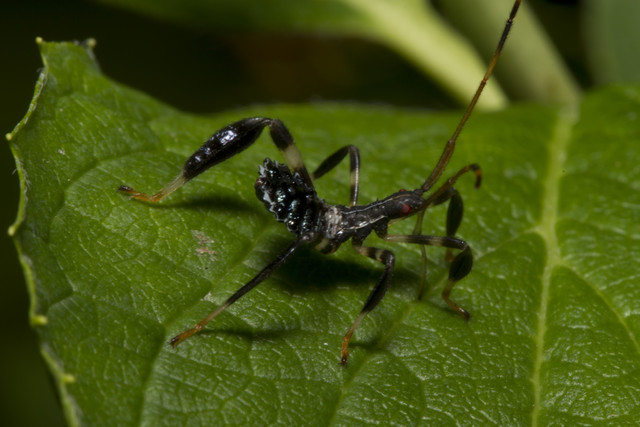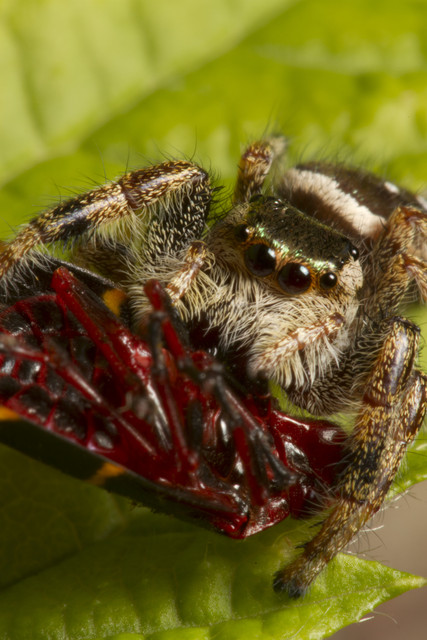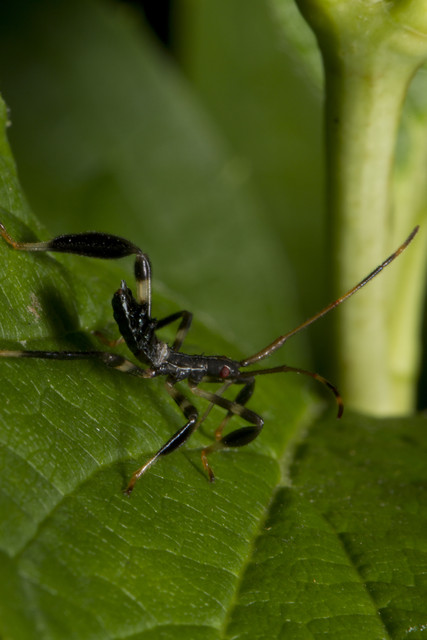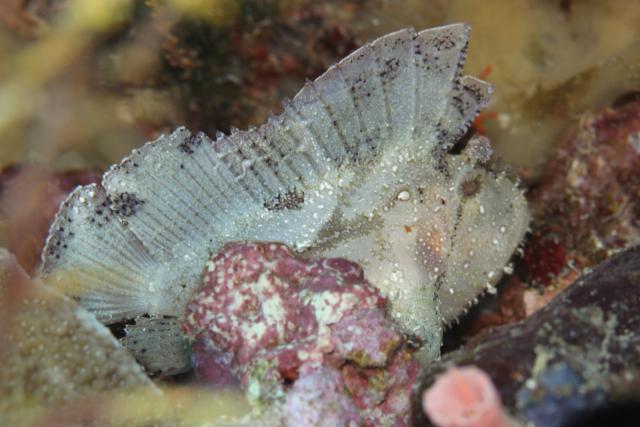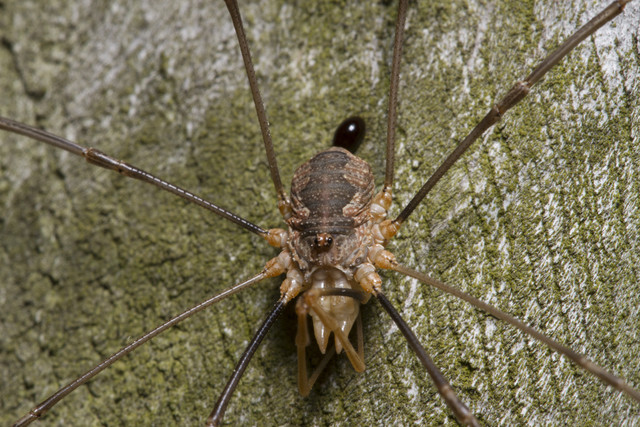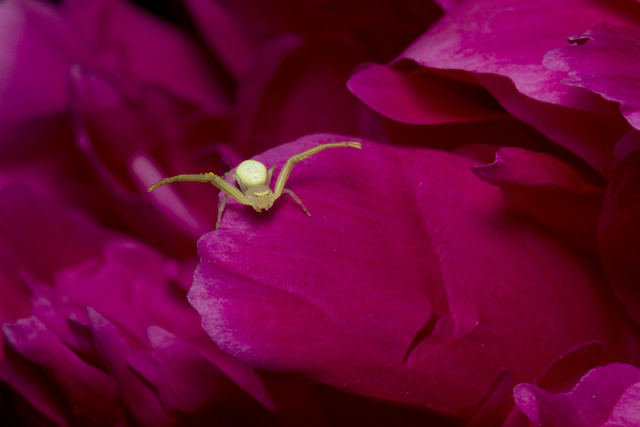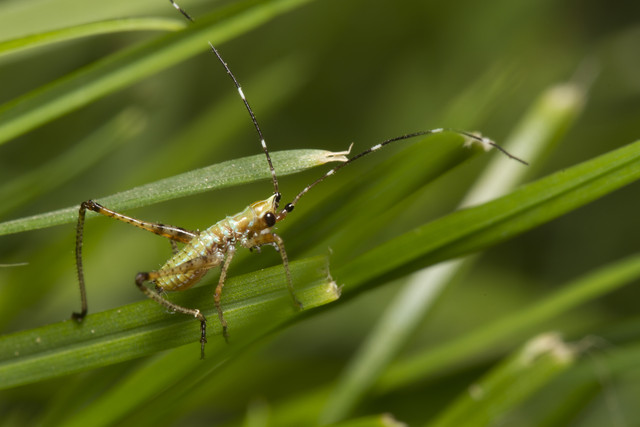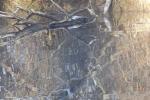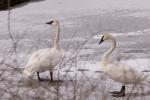macro
Jumping Spider Dinner (part 2)
ktuli — Tue, 07/12/2011 - 19:06
Here's another of that jumping spider with his dinner. This one was taken without the teleconverter, so the magnification isn't as dramatic, but I feel this shot has a bit better composition than just a super-macro shot.
Technical Data: Canon EOS 7D, Canon EF 100mm f/2.8L Macro IS USM, 1/250 sec at f/16. Canon Speedlight 580EX II flash in auto mode and wireless control. Image Stabilization on. ISO 160. RAW processing in Adobe Camera Raw.
Why This Photo: When I found this little guy digging into his dinner, and saw what a cool jumping spider he was, I simply had to see what kind of shots I could manage with him.
What Works: The best item of this shot is the way the metallic green color shows up on the spider's body. This color only appeared on certain angles, so I did have to make some sacrifices to get it, but I think it was worth it. The DoF works to get almost the whole spider in clarity (only possible because of the light provided by the 580EX), and the focus is sharp right on the spider's face. And the bright green leaf produces a nice pleasing background.
What Doesn't Work: To get the green metallic color, I had to sacrifice getting the spider's face and eye contact (many of the other shots have great catchlights in the eyes). Also, the composition would probably have been better if the spider were in the upper right corner, but that simply depended on where the spider was on the leaf (in fact, the edge of the leaf shows in the very bottom left corner).
What do you think? Drop me a comment and let me know.
- Bill
Assassin Bug (part 2)
ktuli — Sun, 07/10/2011 - 17:23
As promised, here are a couple more shots of the ninja assassin bug (ok - that's not a technical name, but it sure looks like a ninja!).
Technical Data: Canon EOS 7D, Canon EF 100mm f/2.8L Macro IS USM with Kenko Teleplus PRO 300 "DG" AF 2x Teleconverter, 1/250 sec at f/22. Canon Speedlight 580EX II flash in auto mode and wireless control. Image Stabilization on. ISO 160. RAW processing in Adobe Camera Raw.
This first one was actually taken inside the light tent. I had trapped the bug in a small tupperware container and transported it to our light tent hoping to get some shots of it on a nice white background. Unfortunately, I think the bright lights really bothered it and it would not sit still for very long. I managed to get a few shots, but more of the time was spent trying to keep it from running away. After a bit, I decided that it was just far too stressed by the ordeal and transferred it back outside.
Fortunately, once it was out of the bright lights and back on a plant outside, it sat still very nicely. Unfortunately, it was 10PM at night, and already very dark outside. So capturing images of it was a challenge. Particularly, focusing was extremely difficult. I had to almost guess at the focus - using the outline of the bug against whatever light source I could find.
In the end, I was able to get a couple shots including the one I shared the other day and this one:
Technical Data: Canon EOS 7D, Canon EF 100mm f/2.8L Macro IS USM, 1/250 sec at f/22. Canon Speedlight 580EX II flash in auto mode and wireless control. Image Stabilization on. ISO 160. RAW processing in Adobe Camera Raw.
I was really glad that I was able to get some good shots of such an interesting subject - despite the difficulties presented.
- Bill
Jumping Spider Dinner (part 1)
ktuli — Sun, 07/10/2011 - 15:36
Ok - I am sorry to start another multi-part series right after beginning a different oe, but I found this little guy last night and really want to start sharing the photos. So I promise to get back to the assassin bug, but it will just be interspersed with this jumping spider.
I found this guy on a leaf on one of the plants out front. Because of where he was located, I simply decided to pinch off the leaf he was on and relocate him to the floor of our front porch. He had obviously just captured this insect (the legs were still twitching) he was starting to tuck into, so I wanted to be careful not to cause him to lose his meal. Apparently there was little risk of that. Over the twenty minutes or so that I was photographing him, he never once let go of it, and probably didn't ever stop eating (by the end, the bug was much smaller and shriveled).
As if typical for me these days, I shot these using the Speedlight 580EX II on a Siegelight bracket and Lumiquest Mini-Softbox and controlled wirelessly by the Canon 7D and my new favorite lens in the Canon EF 100mm f/2.8L Macro, and after a few initial shots with that setup - I usually toss in the Kenko 2x teleconverter. All told, the setup allows me to get shots that I never would have imagined possible before. The Canon 100mm lens provided some excellent image quality, and the image stabilization helps to let me shoot handheld (which I probably shouldn't do), while the flash allows me to stop down the aperture (often to f/16 or higher) for greater depth of field, and finally the teleconverter allows me get 2:1 (twice life-size) magnification.
What that all translates to is getting to see the culinary habits of jumping spiders in incredible detail - though I am sure there are those of you who don't think that is a good thing, but oh well. :)
Technical Data: Canon EOS 7D, Canon EF 100mm f/2.8L Macro IS USM with Kenko Teleplus PRO 300 "DG" AF 2x Teleconverter, 1/250 sec at f/16. Canon Speedlight 580EX II flash in auto mode and wireless control. Image Stabilization on. ISO 160. RAW processing in Adobe Camera Raw.
Stay tuned and I'll continue sharing shots of the assassin bug and this jumping spider.
- Bill
Assassin Bug (part 1)
ktuli — Fri, 07/08/2011 - 07:24
Ok - just a quick post because I want to share this... I found this guy yesterday and had to get a couple photos of him. I had found a larger one a couple weeks ago, but wasn't able to get any photos.
This is an assassin bug - I believe a sub-adult.
Technical Data: Canon EOS 7D, Canon EF 100mm f/2.8L Macro IS USM, 1/250 sec at f/22. Canon Speedlight 580EX II flash in auto mode and wireless control. Image Stabilization on. ISO 160. RAW processing in Adobe Camera Raw.
I will share more about assassin bugs and their behaviors as well as the challenges I faced taking these photos at a later time.
Thanks for stopping by.
- Bill
Jumping Spider Web
ktuli — Wed, 07/06/2011 - 19:18
So I didn't realize that some jumping spiders actually build themselves a web. I'm not sure what the purpose of this little spider's web is - whether it is for trapping food, or just protection overnight, or for laying eggs. But I sat and watched this little spider spin this web for about fifteen minutes the one evening (and then I forgot this photo was still sitting on the card)
Technical Data: Canon EOS 7D, Canon EF 100mm f/2.8L Macro IS USM, 1/250 sec at f/16. Canon Speedlight 580EX II flash in auto mode and wireless control. Image Stabilization on. ISO 160. RAW processing in Adobe Camera Raw.
Sorry I have been lazy with posting recently... just been having a hard time keeping myself motivated, and I've been trying to get outside every once in a while and enjoy the weather and get some exercise. I don't know if I'll pick up with regular posts again any time soon or not, so I'm not going to make any promises.
Thanks for stopping by.
- Bill
Wakatobi: Leaf Scorpionfish
ktuli — Wed, 06/22/2011 - 20:42
Just a quick shot to share today. This cryptically camouflaged critter is a Leaf Scorpionfish (Taenianotus triacanthus). They are sometimes so hard to spot that one member of our group was actually looking past the one we were pointing to, trying to figure out what was hiding behind it that we could have been pointing to! These little guys even sway in the water to mimic a dead leaf or seaweed.
Technical Data: Canon EOS 7D, Canon EF 100mm f/2.8L Macro IS USM, 1/25th sec at f/8. Image Stabilization on. ISO 400 (Auto). Ikelite Housing and Port with Ikelite 161 Strobe in TTL Mode. Auto-smartfix and Removed Color Cast in Photoshop Elements 8.0 (mouseover for original)
I really wish I could go diving soon. Like, really soon.
- Bill
Poll: Katydid Nymph (part 3)
ktuli — Fri, 06/10/2011 - 06:40
So after looking at the shot from the other day, and thinking about the elements that I wished could have been improved with that shot, I decided that perhaps a simple crop would make the shot better.
So here's the crop and the original... place your vote and let me know which one you think looks better.
 Original |
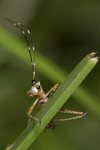 Cropped |
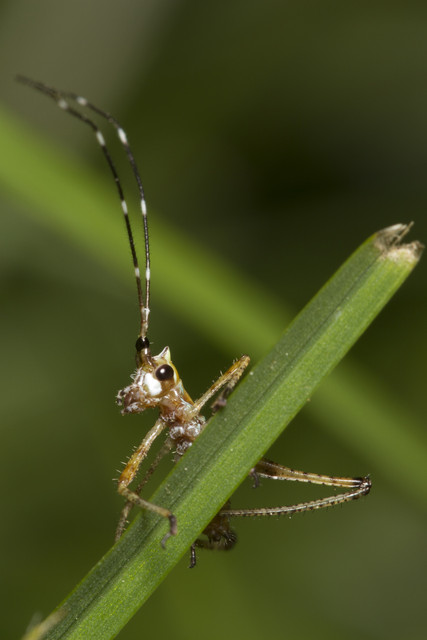 |
|
Technical Data: Canon EOS 7D, Canon EF 100mm f/2.8L Macro IS USM, 1/250 sec at f/11. Canon Speedlight 580EX II flash in auto mode and wireless control. Image Stabilization on. ISO 160. RAW processing in Adobe Camera Raw.
As usual, place your vote and then drop me a comment and let me know why you chose the one you chose.
- Bill
Harvestman
ktuli — Wed, 06/08/2011 - 18:45
Ok - I will admit... if you don't like spiders, you probably won't like this shot. Though technically, this isn't a spider. It is in the arachnid class, but it is in the Opiliones order.
But either way, they are much more alien looking than spiders (and if I'm honest, much uglier!).
Their common names are Harvestmen or Daddy-Longlegs, and you've likely seen them before but probably not like this.
They differ from spiders in a number of ways. First, they possess no silk glands nor venom glands - so they're completely harmless (though this one seems to have something that looks like semi-large fangs). Their body segments are fused (spiders have two body segments - cephalothorax and abdomen), and only have a single pair of eyes (spiders have four pairs of eyes). Harvestmen can also eat solid foods, whereas spiders are only able to ingest liquids.
Ok - if you're still here with me... you must be willing to see the shot...
Technical Data: Canon EOS 7D, Canon EF 100mm f/2.8L Macro IS USM, 1/250 sec at f/11. Canon Speedlight 580EX II flash in auto mode and wireless control. Image Stabilization on. ISO 160. RAW processing in Adobe Camera Raw.
Obviously, the legs on this guy weren't even going to come close to staying in the frame if I was going to get the same level of detail on the body. Most of those legs don't even have the first joint in the shot. The body on this harvestman was maybe 5mm long, so extremely tiny.
Pretty hard to get the detail here but I think I did pretty well.
My apologies if you're freaked out by that shot...
- Bill
Return of the Crab Spider (part 2)
ktuli — Tue, 06/07/2011 - 17:16
Ok - back to the crab spider that was living in one of the peony flowers in our garden for today. This was a very tiny little spider, and today's shot gives a little more scale by backing up a little and showing more of the flower along with the spider.
Technical Data: Canon EOS 7D, Canon EF 100mm f/2.8L Macro IS USM, 1/250 sec at f/16. Canon Speedlight 580EX II flash in auto mode and wireless control. Image Stabilization on. ISO 160. RAW processing in Adobe Camera Raw.
By backing up a little, I manage to show a little scale (though nothing near normal size). I think often times, folks think that these bugs I find are the size of my hand because of the magnification the macro lens produces. In reality (and if my math is correct) had an arm span of only about 9-11mm. Pretty tiny.
The other thing this shot shows is some of the behavior of the crab spider. (This part will probably creep out those of you who don't like spiders, so skip the rest of this paragraph if you're in that group). Crab spiders are pretty aggressive. They often take down prey much much larger than themselves, and they do that with those long, powerful, front legs. They lie in wait and pounce on their prey, holding it with those long legs while injecting their venom. Both crab spiders that I have photographed showed basically no fear of me at all, including threat displays and lunging forward towards my hands and the camera. Very impressive little attitudes. Despite their attitudes and ability to take down large prey, they are harmless to humans.
Often times, crab spiders live on flowers that are close to the color they are (some can slightly change their colors to match the flowers exactly), so this little guy living in a pink flower is kind of strange. The camouflage at work here is actually based on the pollen stamens in the flower. When hiding between the petals, this little spider was about the size and color of the yellow pollen stamens which are layered between the different petals in a peony flower. And it was very quick to move around the flower, quickly climbing between petals, crawling from one side to the other side of a petal, and traversing the whole flower with surprising speed - though it never moved very quickly, just very directly.
See - there are reasons why I am fascinated by little critters like this. I know they're often considered creepy or even scary, but they really are interesting creatures.
- Bill
Katydid Nymph (part 2)
ktuli — Mon, 06/06/2011 - 19:54
Well, like I said, it was a short respite from the bug photos (sorry mom) and we're bouncing back to the katydid nymph from the other night.
This is another one from towards the end of the shoot when I was laying in the grass to get the low perspective to put the view in the katydid nymph's world. That's part of the allure of macro photography for me - to be transported to different worlds that exist right under our feet just by looking through the lens.
Technical Data: Canon EOS 7D, Canon EF 100mm f/2.8L Macro IS USM, 1/250 sec at f/16. Canon Speedlight 580EX II flash in auto mode and wireless control. Image Stabilization on. ISO 160. RAW processing in Adobe Camera Raw.
What Works: Again, a lot of the elements from the shot the other day work again here. The one added nice feature here that makes the shot a little more appealing is the fact that the front leg blocks the mouth parts a bit - I have to be honest and say that this little critter has some weird mouth parts that are probably a bit creepy to some folks, so getting them partially obscured probably is a good thing.
What Doesn't Work: Again here, the shot was taken on such a weird angle - technically the camera interpreted the shot as a vertical shot, but I rotated it back 90 degrees clockwise. The only problem with that is that the grass doesn't necessarily come from the bottom of the frame then. Again, another bright blade of grass in the background is a distraction.
If you like the bug shots, stay tuned as I have a couple more days worth to share. Thanks for stopping by.
- Bill

